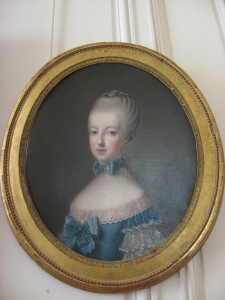
A young Marie Antoinette. By Jean-Baptiste Charpentier le Vieux. Currently hanging in the second antechamber of the Dauphin.
I was going to write a blog post based on the pictures I’d taken of various artwork at the Chateau de Versailles. This was meant to complement the other two posts I’ve created to share the pictures I took at the palace.
However.
I stumbled upon Google Earth Project’s collection of Versailles’ art and was shamed into submission. Google has officially taken over the world. I’m aware this (meaning Google Art not Google world dominance, which is old news) is not something brand new, which is comforting since the end of the Mayan calendar is near. (This whole Google Art Project makes me fear that the end of the Mayan calendar will lead directly into the beginning of the Age of Google. A Google-apocalypse.)
Too bad I didn’t cotton on to the Google Art Project earlier. Everyone from the National Ballet of Canada to the Latvian National Museum of Art are part of this amazing effort.
Here’s the link to the collection of the Chateau de Versailles: http://www.googleartproject.com/collection/palace-of-versailles/
And here, you can do a walk-through of the palace: http://www.googleartproject.com/collection/palace-of-versailles/museumview/
The entirety of the collection is, naturally, worth a look. You can click on the pictures to zoom in, and click details to get some in-depth information about each artwork. Many of them also have educational videos included.
I admit to being most interested in the portraits, especially the ones of people I don’t know well, such as Louis de France, Duke of Burgundy or Maria Leszczinska. But it’s good to see better-known portraits like this one of Louis XIV, or this one of Marie Antoinette and her family.
Read more . . . Continue reading





















